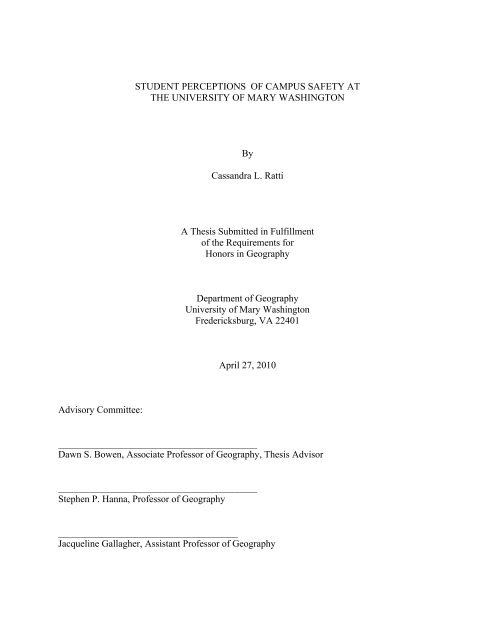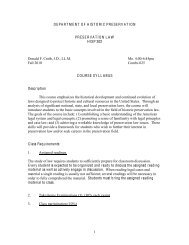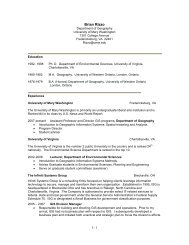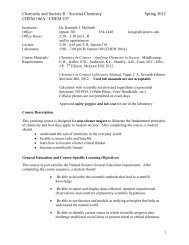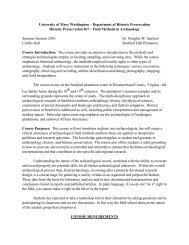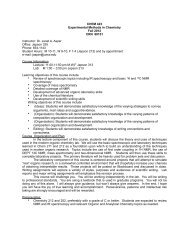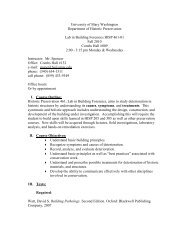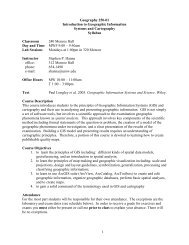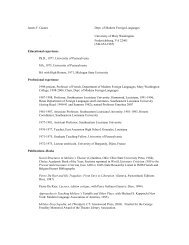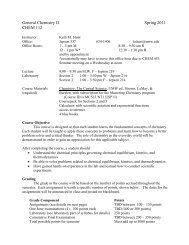STUDENT PERCEPTIONS OF CAMPUS SAFETY AT THE ...
STUDENT PERCEPTIONS OF CAMPUS SAFETY AT THE ...
STUDENT PERCEPTIONS OF CAMPUS SAFETY AT THE ...
You also want an ePaper? Increase the reach of your titles
YUMPU automatically turns print PDFs into web optimized ePapers that Google loves.
<strong>STUDENT</strong> <strong>PERCEPTIONS</strong> <strong>OF</strong> <strong>CAMPUS</strong> <strong>SAFETY</strong> <strong>AT</strong><strong>THE</strong> UNIVERSITY <strong>OF</strong> MARY WASHINGTONByCassandra L. RattiA Thesis Submitted in Fulfillmentof the Requirements forHonors in GeographyDepartment of GeographyUniversity of Mary WashingtonFredericksburg, VA 22401April 27, 2010Advisory Committee:_________________________________________Dawn S. Bowen, Associate Professor of Geography, Thesis Advisor_________________________________________Stephen P. Hanna, Professor of Geography_____________________________________Jacqueline Gallagher, Assistant Professor of Geography
1IntroductionThe safety of college campuses has become an issue of widespread concern in recentyears. This could be due to more women going to college today than ever before, as women areoften perceived as being more vulnerable than men, or because of a higher perception of risk dueto several high profile cases being covered by the national media in recent years. Whatever thereason, safety is a growing concern that must be addressed by college campuses, particularly byadministrators. In order for college administrators to address safety concerns, they must be awareof the types of safety issues present on their campus.This study focuses on student perceptions of safety at the University of MaryWashington. By focusing on student perceptions, this research aims to reveal the types of safetyissues students are concerned about, as well as how students perceive safety on campus and howthey use and perceive various security services on campus. Investigation of student perceptionsof safety on campus is more useful than, for example, focusing solely on crime statistics oncampus. This is because, ultimately, college administrators should address both student concernsas well as reported incidents. The results of this project could prove to be a useful tool to help theUniversity of Mary Washington administration understand the types of safety issues students areconcerned about on campus.Literature ReviewConsiderable research has been conducted on the broad field of perceptions of safety,particularly on the relationship between women’s fear of crime and public space. In recentdecades, much more focus has been directed toward the specific topic of student perceptions ofsafety on college campuses, however, there are gaps in the literature and the field is stillgrowing. This topic falls within several subfields of human geography, with most of the literature
2relating to social geography. There have also been specific studies on this topic related to urbanand transportation geography. Most of the literature relevant to this topic is in the form ofscholarly studies, which include both quantitative and qualitative data. Other relevant literaturefor this topic includes campus crime statistics and related news articles, such as the University ofMary Washington (UMW) 2009 Annual Security Report, as well as campus safety articles fromThe Bullet, the UMW student newspaper. The main themes evident among the literature include:perceptions of safety relating to physical structures (including lighting, buildings, andlandscaping), perceptions of safety relating to specific types of incidents (including sexualassaults, harassment, physical violence and abuse, theft), precautions taken by students relatingto safety, and issues with campus security services and administrations. Nearly all of theliterature on this topic explores, to a varying degree, the differences in perceptions of safetyamong men and women.Speaking to perceptions of safety relating to physical structures, Fletcher and Bryden(2007, 1153) cite lighting and signage on campus, and the availability of emergency phones asthe top three physical safety features of concern on college campuses. This is very importantwhen considering campus safety in terms of specific factors in safety perceptions or designingpreventative measures, but more information is needed about the overall campus physicalenvironment. Loukaitou-Sideris and Fink (2009, 555) explore the campus physical environment,stating that certain environmental factors in public settings and their immediate neighborhoodsare generally associated with greater perceptions of fear. More specifically, Loukaitou-Siderisand Fink state that there is a strong correlation between a run-down physical environment and aperceived fear of that environment. They go on to say that factors such as darkness, desolation,lack of other people in surrounding areas, and poor maintenance can influence perceptions of
3fear about the public setting. In addition, Loukaitou-Sideris and Fink describe the specific designcharacteristics of public space which can influence perceptions of fear, such as places wherethere are obstructions in one’s line of sight, where there are many spaces in which someonecould hide, and where one would feel trapped, without possible escape routes.The problem with looking at these physical structures or the design of a campus is thatthose data focus on the physical environment, ignoring the social environment. Johnson (2009,452) defines the physical environment of a campus as the physical space in which campusviolence occurs. This can be more broadly stated as the physical locations in which campus lifeor campus activities occur. Johnson lists space design, space use and circulation patterns,territorial features, and physical deterioration as the main elements of the campus physicalenvironment. This contrasts with the social environment of campuses, which Johnson defines asthe nature of interactions, or social norms, that occur among students and other members of theuniversity, within the physical environment of the campus. Johnson concludes that the socialenvironment of the campus impacts the behavior of students both at the individual and collectivelevels. At the individual level, it is the student’s individual beliefs, commitments, involvement,and attachment towards the social environment that impacts behavior. At the collective level,campuses with a cohesive, uniform set of social norms have a social environment whichpromotes collective action among students. Because the physical and social environments areinvariably related to one another, it is important to consider both the campus physical and socialenvironments when studying campus safety. Currie (1994, 25) explains that target hardeningstrategies, which reduce opportunities for crimes to occur, such as better lighting, become theprimary means of alleviating concerns if only the physical environment of a campus isconsidered. Pain (2000, 370) even argues that the social environment operating within particular
4spaces is more important to perceptions of safety and fear of crime than the physicalenvironment. In any case, it is necessary to consider both the social and physical environment ofa campus in order to completely address concerns for campus safety.When thinking about specific incidents, student perceptions of safety vary widelybetween men and women. For example, Currie (1994, 33) found that a significantly highernumber of women reported experiencing threatening incidents on campus than men. Curriebelieves that this higher incidence leads women to be more fearful on college campuses thanmen, and as a result, take more safety precautions than men. In their study, Fletcher and Bryden(2007, 1153) found that women perceive themselves as belonging to a group that they feel ismore victimized than others. The same study also found that high numbers of womenconsciously avoid specific areas of campus during the night, avoid walking alone, and arevigilant for suspicious activity. This shows that women are aware of potential safety risks oncampus, either through common knowledge or first hand experience, and act accordingly toprotect themselves. According to Day (1994), women have an increased level of worry towardscrime on campus, forcing them to adopt precautionary measures and restrict their activities andbehaviors. This leads to limitations in educational, social, and leisure opportunities, which couldeffect the overall quality of life for women on college campuses.Also relevant to student perceptions of safety is risk perception literature. Brown andMorley (2007, 575) explain that the majority of people believe “that their personal susceptibilityto negative events is less than that of the average person.” This is an important implication forcampus safety, where students may perceive their risk to be lower than it is in reality. Relevantrisk perception literature consists of studies which examine specific aspects of campus safety,such as alcohol use or sexual assault. In one such study, Crawford et al. (2008) surveyed female
5students about their perceptions of risks associated with sexual assault during and after socialgatherings. The findings of this study show that most participants did not perceive the potentialnegative consequences of risky behavior, such as accepting a drink from an acquaintance orleaving a drink unattended. Crawford et al. conclude that programs aimed at both awareness andrisk reduction could help to bridge the gap between perceived risk and actual risk related tocampus safety.Many studies report that most students, especially women, take some type of safetyprecaution to protect themselves on campus. These include avoidance strategies (not walking atnight, staying away from specific areas of campus), walking with other students, carrying anobject which could be used as a weapon, or carrying a weapon (Currie 1994, 33). Currie alsofound that men and women use safety precautions differently. Men are much more likely to carrya weapon than women, while women are much more likely to use avoidance strategies. Overall,men were much more likely than women to use no safety precautions at all. Starkweather (2007,365) also found that students may utilize boldness strategies when managing campus safetyconcerns, saying, “People acting boldly do not limit their activities in response to perceptions ofsafety, because they feel that they are safe … individuals may deal with fear by rejecting orovercoming it.” A final way of coping with safety concerns on campus is seeking out campusresources (Kelly and Torres 2006, 32). This strategy, however, was used by very few of thestudents studied by Kelly and Torres, even though most students reported that they were awarethat such resources existed. This could be due to a variety of reasons, including studentsbelieving that they did not need assistance or not having an established relationship with staffmembers at campus resources.
6One of the most common problems explored in the literature relating to issues withcampus security services and college administrations is the fact that many threatening incidentsgo unreported on college campuses. Currie (1994, 25) writes:Given that the recorded assaults against women on my campus are historicallyinfrequent, conventional wisdom encourages administrators to treat women’sfears of victimization as the problem, rather than to read their fears assymptomatic of victimization. The common understanding is … women overestimatetheir risk of assault. This claim that women’s fear of crime is out ofproportion to their actual rates of victimization can lead to the conclusion thatwomen’s concerns are “irrational.”Currie claims that because very few assaults have occurred on her campus, administratorsbelieve that women’s concerns about campus safety are unfounded. Administrators consequentlydecide that the best way to deal with those concerns is to treat the perceptions, rather than theactual issues with campus safety, as the problem. In reality, many threatening incidents gounreported on college campuses. In fact, Copeland and Wolfe (1995, 68) report that less thanfive percent of college women report incidents of rape to the police, and more than half ofcollege women who experience rape tell no one about their assaults. Copeland and Wolfesupport these statistics with studies by the Federal Bureau of Investigation, which show that only10 percent of all rapes and sexual assaults are reported to the police. This is especiallytroublesome because many college administrators and campus safety services base their policiesand programs on the types of crimes and threatening incidents that are reported. Currie’s claim,along with the findings of Copeland and Wolfe, support the fact that when administrators planpolicies and programs, they should consider student perceptions of safety, rather than solelyrelying on crime statistics.The issue of viewing women’s safety concerns as irrational is closely related to theproblem of victim-blaming on college campuses. Kelly and Torres (2006, 33) report: “Women
7students in this study reported that male students chided them when they shared stories of beingvictimized or assisted in women feeling the only way to be safe was to be with a man.” This isobviously problematic because it fosters a culture of victim-blaming, which creates anuncomfortable, and often unhealthy, environment for victims of crime. Other studies, includingCurrie (1994) and Fletcher and Bryden (2007), found that women will often avoid reportingincidents either because they blame themselves or fear that others will blame them for theincident. Again, this is problematic if campus administrators base campus safety initiatives solelyon crime statistics, which may not tell the complete story of campus security.Bohmer and Parrot (1993) delve deeper into the issue of why victims of sexual assault oncollege campuses rarely report incidents to the authorities. These victims often believe that theyare at fault, either because alcohol was involved or because they voluntarily went out with theperpetrator. These victims also worry that if they were to report the incident, the authoritieswould blame them for the assault for the same reasons. Other victims do not report sexualassaults because they believe that the school does not take these incidents seriously, or are illequippedto handle such incidents. They believe that it is not worth the trouble to go through thereporting process when it is unlikely that anything will happen to the perpetrator. In any case, thefact that many incidents, especially those as serious as sexual assaults, go unreported on collegecampuses is disturbing. This is a fact which also must be taken into consideration whenadministrators are considering campus security.On another side of this issue, Gilchrist et al. (1998) explore the argument that womenhave an irrational response to a low threat of crime. This could be attributed to the stereotypesthat women are more vulnerable to attack than men, less able to defend themselves, and less ableto cope with victimization. Other possible causes for women’s heightened fear of crime are that
8women suffer more daily, low level victimization (such as sexual harassment) than men, womenfear sexual assault, which is generally not perceived as a threat for men, and that women fearunusual, serious crimes, which often involve female victims and are exaggerated in the media.Gilchrist also suggests that women are socialized to fear public space, strangers, and men, andthus have a higher fear of crime in general. It is important to note that many of these claimsconcerning women’s high fear of crime have been challenged by other research, includingresearch that shows many crimes against women go unreported (see Bohmer and Parrot 1993;Currie 1994; Fletcher and Bryden 2007; Copeland and Wolfe 1995). In particular, Gordon andRiger (1989, 118) argue that it would be irresponsible to advise women to completely stop beingafraid, even if this heightened fear is irrational. Society must first take responsibility for thisfemale fear, and address both actual crime and perceptions of crime against women. Until thisoccurs, fear, and the behaviors that come with fear (such as avoidance strategies), may actuallyprotect some women.Campus security services vary markedly among college campuses, but most studiesreport campus security providing some form of security patrol, safety escort service, emergencyphone system (also known as “blue lights”), and emergency phone numbers. Fletcher andBryden (2007, 1160) found that the majority of people in their study were aware of campussecurity and foot patrols, but fewer people had actually used either of these services. Studentswere much more likely to use avoidance strategies, walk with another person, or use some sort ofweapon (including using keys in a defensive manner) than they were to contact campus securityor use the foot patrol. According to Hall and Sandler (1984, 9), women rarely use campussecurity services, and, in some cases, campus safety personnel may even unintentionally
9discourage women from using such services by diminishing women’s concerns when they reportfeeling threatened.Some studies examine what campus security services could do to minimize safety risks tostudents. Franzosa (2009) states that the most effective way to do this is through encouragingcommunication between students and campus security services. Franzosa argues that bycommunicating that campus security is alert and knows how to react in any situation, studentsare more likely to be informed and participate in campus safety measures. Students also need tobe informed of the risks that exist, without being unnecessarily fearful of the campus. “The keyto fighting campus insecurity is not to create fear or diminish freedom, but rather to keepresources available, raise awareness that threats exist, and maintain open lines ofcommunication” (Franzosa 2009, 21).The literature on student perceptions of campus safety reveals that gender is an importantdimension of this topic, and that there are marked differences in safety concerns between menand women. Several studies on college campuses, such as those of Currie (1994) and Fletcherand Bryden (2007), which present both quantitative and qualitative data, provide insight toperceptions of safety relating to physical structures (including lighting, buildings, andlandscaping), perceptions of safety relating to specific types of incidents (including sexualassaults, harassment, physical violence, abuse, and theft), precautions taken by students relatingto safety, and issues with campus security services and administrations. This project incorporatedinsights from the literature to develop a campus safety perceptions survey and provide questionsfor semi-structured interviews, and expands upon these studies by examining student perceptionsof safety at the University of Mary Washington.
10MethodologyMost of the existing studies on campus safety incorporate both survey and interviewmethods. This methodology is useful for the topic of campus safety because statistics fromsurveys tell only a partial story. In order to determine how students truly feel and perceivecampus safety, some form of personal interviewing must also take place. Starkweather (2007)both used surveying and interviewing methodologies to explore student perceptions of campussafety. Starkweather distributed surveys in general education courses in order to obtain a randomsampling of undergraduate students, then conducted semi-structured interviews with a smallsample of students who, on the survey, indicated willingness to be interviewed. Other studiesused a similar methodology, including Kelly and Torres (2006) and Currie (1994).Like Starkweather’s, this study uses both surveying and interviewing methodologies inorder to get a more complete picture of student perceptions of campus safety, with the firstportion of the research being the surveying phase. In order to distribute surveys and interviewstudents, approval was obtained from the Institutional Review Board (Appendix A). The surveyconsists of four main sections, all of which aim to uncover the beliefs, attitudes, and opinions ofstudents towards campus safety and security services (Appendix B). The first section containsseveral statements concerning personal beliefs towards campus safety, and respondents wereasked to choose strongly agree, agree, neutral, disagree, strongly disagree, or not applicable. Thesecond section of the survey contains yes or no questions, asking whether or not respondentshave ever utilized certain campus security services, including the Campus Police and the BlueLight system. The third section asks respondents to rate campus security services and physicalfeatures on campus, such as the presence of police officers and lighting on campus. Respondentscould select extremely satisfied, satisfied, neutral, dissatisfied, or extremely dissatisfied. The
11fourth section of the survey was an open ended question, asking respondents to identify as manyas three places where they feel the least safe, using a campus map. Finally, there was also asection which asked the respondent to identify their sex, year at the university, and residentialstatusThe survey was distributed in a variety of classes, including introductory and upper levelcourses in several different departments. The goal was to get a random sampling of students,including both men and women, residential and commuter students, and students from differentmajors and class years. In order to minimize the amount of instructional time this survey took outof classes, the survey was distributed at the beginning of the class, and then respondents couldcomplete it on their own time, and return it to the professor during the next class. The responserate for this survey was about 73 percent. This is a relatively high response rate, consideringrespondents had to complete the surveys on their own time, and then bring it back to the nextclass. In the end, 301 surveys were completed, returned, and compiled for the final results,meaning that about 7.5 percent of the undergraduate student body completed the survey.After the development and distribution of the student survey, and compilation of theresults, the next phase of this study was student interviews. Interview questions were developedbased on the results of the surveys (Appendix C). For this study, the interview is simply a toolused to clarify and expand upon responses on the survey, as well as to investigate various trendsfound in the results of the survey. After both the surveying and interviewing phases of the studywere finished, a final analysis was completed to tie together all of the findings. Together, thedata from the surveys and the interview responses aim to provide a more complete depiction ofstudent perceptions of campus safety.
12ResultsOf the 301 students surveyed, 67 percent were female and 32 percent were male (Table1). For the most recent incoming classes at UMW, 65 percent were female and 35 percent weremale, which shows that the survey captured a realistic population distribution in terms of sex. Interms of class year, 33 percent of students surveyed were first year students, 27 percent weresecond years, 22 percent were third years, 16 percent were fourth years, and 1 percent were fifthyears. When examining the results of the survey, it is important to note that the distribution ofclass year among respondents is slightly uneven. This slightly uneven distribution is due to thefact that it was difficult to find professors who were willing to distribute surveys to their upperlevel classes, which would typically have more third and fourth year students. When asked toidentify their residential status, 64 percent live on campus (56 percent in residence halls, eightpercent in the UMW Apartments) and 34 percent live off campus (28 percent in theFredericksburg area, six percent outside the Fredericksburg area). This is consistent with campuswide statistics, which show that 65 percent of students live on campus in residence halls orcampus apartments, and 35 percent live off campus.Table 1: Sex, Class Year, and Residential StatusRespondents Number PercentageFemale 201 67%Male 97 32%1 st Year 98 33%2 nd Year 80 27%3 rd Year 65 22%4 th Year 49 16%5 th Year 3 1%On campus – Residence Hall 170 56%On campus – UMW Apartments 23 8%Off campus – Fredericksburg 84 28%Off-campus - Outside Fredericksburg 19 6%
13Examining the personal beliefs of students concerning safety on campus, the overallresults of the survey show that 86 percent of students surveyed believe that in general, UMW is asafe campus (Table 2). Nearly all students surveyed (99 percent) either agree or strongly agreethat they feel safe being alone on campus during daylight hours, compared to only 54 percent ofstudents surveyed who feel safe being alone on campus after dark. Very few students (6.6%) saidthat they avoid being alone in certain parts of campus during daylight hours, while 56 percentsaid that they avoid certain areas after dark. These overall results show that although moststudents believe this is a safe campus, time of day is an important factor in student perceptions ofcampus safety.Table 2: Personal Beliefs on Campus Safety (as percentage of students surveyed)In general, I believe that thiscampus is safe.I feel safe being alone oncampus during daylight hours.I feel safe being alone oncampus after dark.I avoid being alone in certainareas of campus due to safetyconcerns during daylight hours.I avoid being alone in certainareas of campus due to safetyconcerns after dark.Strongly Agree Neutral Disagree Strongly NotAgreeDisagree Applicable19 67 11 2 0 066 33 0.6 0 0 0.316 38 22 19 3 20.6 6 12 39 40 218 38 12 15 14 3The overall results of the survey show the majority of students surveyed have not utilizedmost of the campus security services listed on the survey (Table 3). Campus police had thehighest number of students who said they have utilized their services, at 26 percent, with muchlower numbers for the other security services. When asked to rate certain campus securityservices, the majority of students were satisfied or neutral towards lighting on campus, bluelights, and the presence of police officers (Table 4). Lighting on campus had the highest
14percentage of students either satisfied or extremely satisfied (57 percent), while presence ofpolice officers had the lowest percentage of students either satisfied or extremely satisfied (41percent).Table 3: Use of Campus Security Services (as percentage of students surveyed)Have you utilized the following campus security services? Yes NoCampus Police 26 74Blue Light System 1 98Emergency Phone Service 5 94Campus Safety Escort 14 85Self Defense Classes 3 96Table 4: Satisfaction with Campus Security Services (as percentage of students surveyed)ExtremelySatisfiedSatisfied Neutral Dissatisfied ExtremelyDissatisfiedLighting on campus 5 52 24 18 0.3Visibility of blue lights 12 44 28 16 0Number of blue lights 8 38 34 19 0.3Location of blue lights 6 40 39 14 0.6Presence of police officers 8 33 36 18 4The results of the campus map portion of the survey show that most respondents feelunsafe in similar areas on campus. This portion of the survey asked respondents to circle up tothree places on a campus map where they feel the least safe. The highest number of studentsindicated that they feel unsafe at the parking deck (22.3 percent), Campus Drive (17.3 percent),and Sunken Road (12.6 percent), with College Avenue, the Sunken Road parking lot, and Mercerpath close behind (Figure 1).When looking at the breakdown of results of the survey by sex, class year, and residentialstatus, the greatest disparity in responses is between female and male responses (Table 5). Theresponses of females and males differ the most for personal perceptions of campus safety duringdaylight hours versus after dark. For example, 31 percent of females either disagree or strongly
15Figure 1: This map visualizes the spatial pattern of student perceptionsof campus safety based on the campus map portion of the survey.
16disagree with the statement, “I feel safe being alone on campus after dark,” compared with onlythree percent of males who feel the same way. More females use avoidance strategies thanmales, with 72 percent of females responding that they avoid certain areas of campus due tosafety concerns after dark, compared to only 18 percent of males. Male and female perceptionsdiffer when it comes to satisfaction with campus security service. For example, 26 percent offemales are either dissatisfied or extremely dissatisfied with the presence of police officers oncampus, compared to only 12 percent of males. It is also important to note that male and femaleresponses were similar for the campus map question, where respondents circled the top threeplaces they felt least safe. The top 3 responses for both men and women were the parking deck,Campus Drive, and Sunken Road. Although there were significant differences in the responses offemales and males, there were very few differences in responses based on class year orresidential status, other than a few important exceptions, which will be discussed later.Table 5: Female vs. Male Responses (Female / Male, as percentage surveyed)In general, I believe that thiscampus is safe.I feel safe being alone on campusduring daylight hours.I feel safe being alone on campusafter dark.I avoid being alone in certainareas of campus due to safetyconcerns during daylight hours.I avoid being alone in certainareas of campus due to safetyconcerns after dark.Strongly Agree Neutral Disagree StronglyAgreeDisagree11 / 36 73 / 57 13 / 5 2 / 2 0 / 059 / 81 40 / 18 1 / 0 0 / 0 0 / 04 / 41 33 / 46 29 / 6 26 / 3 5 / 00.5 / 1 9 / 1 16 / 2 46 / 26 26 / 6825 / 2 47 / 16 12 / 12 10 / 27 4 / 36ExtremelySatisfiedSatisfied Neutral Dissatisfied ExtremelyDissatisfiedLighting on campus 3 / 8 50 / 55 26 / 21 19 / 14 0.5 / 0Visibility of blue lights 8 / 21 46 / 41 25 / 32 20 / 5 0 / 0Number of blue lights 4 / 14 40 / 36 30 / 43 24 / 6 0.5 / 0Location of blue lights 2 / 13 40 / 40 39 / 37 16 / 8 1 / 0Presence of police officers 5 / 14 32 / 36 36 / 36 21 / 11 6 / 1
17After the survey portion of the study was completed, respondents were selected forinterviews based on whether or not they indicated that they would be willing to participate in aninterview on the survey. A total of 10 interviews were completed, with five female and five malerespondents. All of the interview respondents were juniors or seniors, because these class yearswere underrepresented in the survey portion of the study. Overall, the findings from theinterviews support the results of the survey. The majority of the interviews were quite brief,simply because the respondents did not have many safety incidents or experiences with campussecurity services to talk about. Respondents overwhelmingly expressed that they usually feelvery safe on campus, and have never felt uncomfortable or threatened. Respondents alsoexpressed feeling safer on campus during the day versus after dark, especially for females. Onefemale respondent said that although she feels safe on campus at night, she is definitely morevigilant of her surroundings than during the day. Also similar to the results of the survey, nearlyall of the interview respondents said that they have never used any of the campus securityservices listed in the survey, and that they are neutral towards these security services (rather thansatisfied or dissatisfied).Although the majority of the interview respondents were positive, and expressed opinionsabout a very safe campus, there were a few important exceptions where respondents expressedfeeling uncomfortable or threatened at times on campus. One female respondent recounted anexperience where she felt threatened inside a building on campus. When she reported theincident to an authority figure, her concern was wrongly dismissed. Eventually, the campuspolice were notified, but by this time, the student had already lost confidence in campus securityservices. Another male student reported feeling uncomfortable being alone at night in certainparts of campus, including areas near Sunken Road and along the path and steps behind Mercer.
18The student said that he avoids these areas at night because they have poor lighting, low foottraffic, and are heavily wooded. These same concerns were echoed by several other respondents,both male and female.The interviews were also able to expand upon students’ satisfaction with campus securityservices. Respondents agreed that overall, lighting on campus is acceptable, with the exceptionof certain areas, namely near Sunken Road, and behind Mercer, Monroe, and Trinkle. Whentalking about blue lights, respondents questioned the effectiveness of the system. One malerespondent said that he has no confidence in the blue light system because he believes that thepolice respond too slowly to incidents on campus. Another male respondent reiterated thisperception, saying that he would never use the blue light if he felt threatened because the campuspolice would never be able to respond quickly enough. Other respondents questioned the recentaddition of more blue lights on campus (Figure 2). One female student said that these additionalblue lights are unnecessary because the campus already hasgood blue light coverage. She also said that the locations ofsome of the new blue lights, such as at the corner ofSunken Road and Hanover Street, seem to be out of theway for the majority of students.Figure 2: The university recently installed five new bluelights to fill gaps in high traffic areas along CollegeAvenue. Some students believe that these new blue lightsare unnecessary because the university already has goodblue light coverage. With the addition of these new lights,the university has a total of 139 located on and around thecampus.
19When asked about the presence of campus police officers, respondents agreed that theyrarely see officers at all on campus. Multiple respondents said that the only time they see thepolice is when they are issuing parking tickets or driving down College Avenue. One malerespondent talked about how Brent House is a terrible location for the police, and that a morecentralized location would make more sense. A female respondent echoed this complaint, sayingthat she only sees the police around Brent House, and they never go to the Goolrick side ofcampus. During the interviews, the respondents were also asked if they noticed any changes incampus safety, particularly in security services, during their time at UMW. All of therespondents agreed that they have noticed improvements in security services, including increasedlighting, blue lights, and police presence. Most of the respondents noted that there is still roomfor improvement, particularly with police visibility.In addition to general questions about perceptions of campus safety and expanding uponquestions from the survey, there were a few specific questions addressed in the interviews. Thefirst of these questions was about student awareness of campus security services. The results ofthe surveys show that very few students use campus security services (including campus police,the blue light system, emergency phone service, campus safety escorts, and self defense classes).The results of the surveys also show that most students are either neutral or satisfied with theseservices, but not extremely satisfied, nor dissatisfied. One possible explanation for both of thesefindings is that students are unaware of the existence of many of these campus security services,and thus they do not use them, nor do they have a strong opinion about these services. During theinterviews, respondents were asked to identify the security services offered by UMW. Allrespondents were able to identify the campus police, the blue light system, and the campus safetyescorts. Most of the male respondents did not identify the emergency phone service or the self
20defense classes. This makes sense, given that the self defense classes are designed for females.Most of the female respondents were able to identify the self defense classes, but not theemergency phone service. Based on these interviews, it seems that students are aware of theexistence of campus security services, with the exception of the emergency phone service.DiscussionBased on the overall results of the completed surveys, four generalizations can be made.These generalizations are based on the four main sections of the survey: personal beliefsconcerning campus safety, use of security services, satisfaction with security services, and thecampus map. It is important to make these generalizations in order to get an overall sense ofstudent perceptions of campus safety, but at the same time, it is important to remember that theseare generalized interpretations of the overall results of the survey. There are important exceptionsto these generalizations that will need to be analyzed further.The first generalization from the survey results is that students believe UMW is a safecampus. The majority of students (86 percent) agree or strongly agree that in general, thiscampus is safe. Nearly all students surveyed (99 percent) agree or strongly agree that they feelsafe being alone on campus during daylight hours, and more than half (54 percent) agree orstrongly agree that they feel safe being alone on campus after dark. What these results show isthat students feel safe on this campus, both in general, and even more specifically duringdaylight or after dark.This general sense of safety among students on campus could be due to the low numberof reported incidents that occur at UMW. According to the UMW 2009 Annual Security Report,in 2008, there were four forcible sex offenses, three aggravated assaults, four burglaries, and twoarsons. The only other reported incidents that occurred were several incidents of larceny, liquor
21law violations, drug violations, and public intoxication. There were no incidents of criminalhomicide, non-forcible sex offenses, robbery, motor vehicle theft, or weapons possession. In2008, the highest number of reported incidents were liquor law violations (152 incidents, 24arrests), followed by public intoxication (25 arrests), followed by larceny (66 incidents). All ofthese crime statistics are very low, and the serious offenses (homicide, sex offenses, robbery, andassault) are all extremely low or nonexistent. In years past, UMW has had very low crime ratesas well, with the 2007 and 2008 Annual Security Reports being very similar to the 2009 report.This continuing pattern of low crime rates probably contributes to the general perception ofstudents that UMW is a safe campus.The second generalization from the survey results is that the majority of students neverutilize the campus security services included in the survey (campus police, blue light system,emergency phone service, campus safety escorts, and self defense classes). In fact, 98 percent ofstudents have never used the blue light system, and 85 percent have never used a campus safetyescort. In addition, 94 percent of students surveyed have never used the emergency phoneservices. Although more students (26 percent) have used the campus police than these otherservices, this number is still relatively low. Very few students (3 percent) have taken a campusself defense class, but this is likely due to the fact that the classes are very small, and are not ableto accommodate large numbers of students.One possible explanation for low numbers of students using campus security services isthe fact that few incidents actually occur on campus, according to the 2007-2009 AnnualSecurity Reports. If few incidents are actually occurring, then there is no reason for very manystudents to use these campus security services. Another possible explanation is that few studentsare aware of the existence of these campus security services. This is probably not true in the case
22of the blue lights and campus police because the majority of students have encountered theseparticular security services at some point during their time at UMW, either during freshmenorientation or while simply walking around campus. In addition, The Bullet, the UMW studentnewspaper, has a weekly column that is widely read by students that reports incidents handled bythe campus police. The Bullet has also featured several articles about the blue light system,including “Five Emergency Lights Added” (Wilkerson 2010), so it is unlikely that many studentsare unaware of the existence of the blue light system. It is possible, however, that students areunaware of the existence of the emergency phone service and campus safety escorts. Accordingto the interviews conducted, students are aware of the existence of safety escorts, but not theemergency phone service. This suggests that students are not using the safety escorts becausethey do not perceive a need to use them. The same could be true for the emergency phoneservice, or it could be that students are simply not aware of its existence.The third generalization from the overall survey results is that students are either neutralor satisfied with the campus security services and features included in the survey (lighting oncampus, visibility, number, and location of blue lights, and presence of police officers). Onaverage, 74 percent of students surveyed are either neutral or satisfied with these services andfeatures. Although these students are not dissatisfied or extremely dissatisfied, they are notextremely satisfied either. This suggests that students may not know very much about thesesecurity services or have little experience with them. This makes sense, given that crime rates arelow on campus, so students may not have the opportunity to use these services, and thus theywould not have a strong opinion one way or another. Another possible explanation is that, again,students are unaware of the existence of these security services. Results from the interviews
23show that students are aware of the existence of most security services, so this explanation isprobably inaccurate.The fourth generalization from the surveys is that students feel the least safe in similarlocations on campus. This generalization is based on the section of the survey where studentscircle up to three places where they feel the least safe on a campus map. The results from thisquestion show that there is great similarity in these responses, with the highest number ofstudents indicating that they feel the least safe around the parking deck, Campus Drive, andSunken Road (see Figure 3). This generalization holds true for both female and male responses,but there is an important exception to this generalization for class year.It is important to stress that these generalizations about the overall results of the surveydo have some important exceptions. The most notable exception is the disparity in responsesbetween females and males. This is not surprising, given that the difference in female and maleperceptions of safety is an important theme raised in relevant safety literature (see Currie 1994;Day 1994; Fletcher and Bryden 2007; Kelly and Torres 2006). The responses of females andmales differ the most when talking about perceptions of campus safety during daylight versusafter dark, and when it comes to satisfactions with campus security services and features. Femalestudents seem to feel much less safe being alone on campus after dark than male students.Females are also much more likely to use avoidance strategies due to safety concerns when aloneon campus after dark. All of these findings conform to relevant safety literature. For example,Klodawsky and Lundy (1994, 134) found that women, unlike the majority of their male peers,often suffer anxiety and stress associated with fear of crime on campus. This directly affects thebehavior of women, often leading to avoidance strategies, which limit participation in university
24Figure 3: According to the campus map portion of the survey, students feel the least safe aroundthe parking deck (upper and lower left), Campus Drive (upper right), and along Sunken Road(bottom right).life. In addition, Currie (1994, 33) found that men are much more likely to carry a weapon or touse no safety precautions at all, while women are more likely to use avoidance strategies. Theresults of the survey, as well as further interviews, suggest that these claims hold true forstudents at UMW.Female and male responses on the survey were similar for one important area, thecampus map where respondents were asked to circle up to three places on campus where theyfeel the least safe. The top three responses for both men and women were the parking deck,Campus Drive, and Sunken Road. It is interesting that female and male responses differ in so
25many other categories of the survey, but are the same for this question concerning the spatialdistribution of perceptions of campus safety. This suggests that the parking deck, Campus Drive,and Sunken Road have very similar, prominent features that make students, men and womenalike, feel unsafe. All of these places are relatively poorly lit and not well traveled, especiallyafter dark. With the exception of the parking deck, the campus police presence at these places isalso minimal. Within the last two years, the university has placed two security guards near theparking deck after dark. As the results of this survey show, however, students still feel unsafe atthe parking deck, despite the presence of security guards. This suggests that lighting could be thetop determinant in whether or not students feel safe in a particular place, more so than policepresence or volume of foot traffic. Fletcher and Bryden (2007, 1153) support this claim, citinglighting and signage on campus, and the availability of emergency phones as the top threephysical features of concern when it comes to campus safety. This is very important whenconsidering campus safety in terms of specific locations and factors that create safetyperceptions, as well as for designing preventative measures.Although there were significant differences in the responses of females and males, therewere very few differences in responses based on class year. This is probably because themajority of students surveyed indicated that they generally feel safe on campus, so there is nosignificant distinction among different class years. One exception to this is that freshmenreported a much greater range of locations where they felt the least safe on the campus mapquestion. The majority of sophomores, juniors, and seniors reported the same locations as theoverall results, with the highest numbers for the parking deck, Campus Drive, and Sunken Road.A possible explanation for this difference in freshmen is that freshmen do not have cars oncampus. Because of this, they do not regularly use the parking deck, Campus Drive, or Sunken
26Road, and so they would not perceive these places as being unsafe. In addition, becausefreshmen do not have cars, it is likely that they walk to more places than upperclassmen. If theywalk to more places, then they have more opportunities to come across places where they mightfeel unsafe. This would lead to a greater range of locations for freshmen on the campus mapquestion. Differences in perceptions of safety among students of different class years has notbeen widely discussed in the relevant literature. Kelly and Torres (2006, 33) find that graduatestudents appear to be more aware of the potential risks of walking o campus alone at night thanundergraduate students, but they do not report any findings based on undergraduate class year.This particular area of study could be the basis for further research.There were also very few differences in responses based on residential status for both thesurveys and interviews. One exception to this is that more students living on campus report usingcampus police services than students living off campus. This is not surprising, given that studentsliving off campus do not spend as much time on campus as residential students, and so theywould be less likely to need the services of the campus police. What is surprising is that such ahigh number of students living in the UMW Apartments report using the campus police. Nearly43 percent of students living in the apartments report that they have used the campus policeservices, compared to only 25 percent of all students surveyed. This could be higher becausestudents living in the apartments are juniors or seniors, so they have spent more time on campus,and have had more opportunities to use the campus police. Another more disturbing possibility isthat something about living in the apartments makes students feel more unsafe, and this is whymore students living in the apartments report using the services of the campus police.Interviews with students living in the apartments were conducted to attempt to find out ifthis high rate of use of campus police is due to something about living in the apartments, or some
27other outside factor. During the interviews, respondents were asked if they have ever used theservices of the campus police, and if so, whether or not the incident was in any way related to theapartments. The interview respondents reported that they had never used the services of thecampus police for a safety issue. Upon further questioning, the respondents went on to say thatthey had never felt threatened or uncomfortable in the vicinity of the apartments. In order todetermine the answer to this question from the survey results, interviewing would have to takeplace on a larger scale at the UMW Apartments.Looking at the map of these responses to the campus map portion of the survey (Figure1), there other interesting patterns that emerge. This first pattern is that students seem to feelmore unsafe in buildings and structures along the edges of campus, including the Battlegrounds,Sunken Road, College Avenue, the parking deck, and the Thornton Street parking lot. Studentsseem to feel safer in buildings and structures located along the interior of campus, such asWillard Hall, Simpson Library, Ball Circle, and Trinkle Hall. This could be due to a number ofdifferent factors, such as poor lighting and decreased foot traffic along the outskirts of campus,as compared with the interior of campus. Another pattern seen on the map is that students seemto feel safe in all of the academic buildings and most of the residence halls. Students seem to feelthe least safe in student services and athletic buildings, including the Fitness Center, GoolrickHall, Seacobeck Hall, and Woodard Campus Center. Again, there are a number of factors thatcould contribute to this pattern. A likely possibility is that students feel safe in residence hallsbecause they are always locked, and they feel safe in academic buildings because they areusually there during the day with several other students. Students might feel less safe in studentservices and athletic buildings because they are often there after dark, or when there are fewother students around.
28Looking back at the overall study there are some problems with the structure of the study,particularly with the survey, and areas for improvement. With the survey itself, it is apparentafter careful review that some questions could be misinterpreted. In the second section of thesurvey, which asks: Have you utilized the following campus security services?, respondentscould be confused or have different ideas about what is meant by utilized. This is especially truefor the first item in the section, the campus police. What does it mean to utilize the campuspolice? A better way of structuring this section might be to make each item (campus police, bluelight system, emergency phone service, campus safety escort, and self defense classes) a separatequestion. For example, the restructured questions would read: Have you ever called the campuspolice due to a safety concern? Have you ever requested a campus safety escort? Have you evertaken a self defense class on campus? These questions are more specific, and would likelyreduce any confusion for respondents.Another problem with this study was the distribution of the survey. Ideally, the surveywould have been distributed to more students, resulting in closer to 400 completed surveys (orabout 10 percent of the undergraduate student body). However, some faculty members were notwilling to have the surveys distributed in their classes. This was especially problematic amongupper level courses, many for which professors said they could not spare any class time for thedistribution of a survey. It was easier to survey introductory level courses, where professors saidthey could spare a few minutes of class time to distribute the survey. This led to a slightlyuneven distribution in class year among survey respondents, as most introductory level courseshave more freshmen and sophomores than juniors and seniors. Starkweather (2007, 360), whoadministered surveys in general education courses, reports this same problem of overrepresentationof freshmen and sophomores and under-representation of seniors. Ideally, there
29would have been a more even distribution of class year among survey respondents. In order totry to overcome this, the interview portion of the study focused on the opinions and responses ofjuniors and seniors.Finally, the campus map portion of the survey proved to be difficult both for therespondents and for interpretation purposes. Several respondents (20 percent) did not completethis portion of the survey. This could be because these students do not feel unsafe anywhere oncampus, and some students wrote this on the map. It is also possible that these students eitherforgot to fill out the campus map, or did not want to take the time to complete this portion of thesurvey. In any case, the fact that 20 percent of respondents did not complete this section issomething that must be taken into consideration when examining the results. For this reason, itwas difficult to interpret the results of the campus map question. Another difficulty was thatsome respondents circled very large areas on the map, encompassing several buildings and otherstructures. This made it difficult to produce an accurate map displaying the overall results fromthis portion of the survey. In order to try to overcome this, locations were simplified into moreconcise, defined areas. For example, if a respondent circled one entrance to Seacobeck on themap, this response was mapped as if the respondent had circled the entire building. Similarly, if arespondent drew one circle around Alvey, Arrington, and Goolrick, this response was mapped asif the respondent had circled each building separately. This method was used so that the resultingmap would be easier to read, and so that the map would be more meaningful.ConclusionOverall, the results of this study indicate that in general, students believe that UMW is asafe campus. Both student surveys and interviews confirm this notion: 86 percent of studentssurveyed agree that this is a safe campus, and all ten students interviewed report that they feel
30safe on campus. These findings show a level of perceived safety that is consistent with actualcrime reports on campus. Very few crimes actually occur on campus, according to AnnualSecurity Reports, so in other words, students are not overestimating or underestimating their riskpertaining to campus safety. One important caveat to this conclusion is that many scholars arguethat the majority of crimes on college campuses, especially sexual assaults, do not get reported tothe authorities (see Bohmer and Parrot 1993; Currie 1994; Fletcher and Bryden 2007). Forexample, Copeland and Wolfe (1995, 68) report that less than five percent of college womenreport incidents of rape to the police, and more than half of college women who experience rapetell no one about their assaults. If campus crime rates are much higher in reality then what theAnnual Crime Reports show, then it is possible that student perceptions of safety actuallyunderestimate the risk associated with college campuses.The results of the surveys and interviews also indicate that few students use campussecurity services, such as campus police, blue lights, or campus safety escorts. The interviewportion of the study revealed that students are aware of these services, they simply choose not touse them, or do not feel the need to use them. This is consistent with findings in relevantliterature, such as Fletcher and Bryden (2007, 1160) who found that the majority of people intheir study were aware of campus security and foot patrols, but much fewer people had actuallyused either of these services.The findings from this study also indicate where further investigation, and in some casesimprovements in campus safety, should be directed. One area that needs to be addressed is thedisparity between female and male perceptions of campus safety. Further research must beconducted in this area in order to discover ways in which college campuses, and UMW inparticular, can close the gap between female and male perceptions of campus safety. The lack of
31overall satisfaction with campus security services is also an area of campus safety that needs tobe improved. Although many respondents indicated that these services are making progress,there is still room for improvement. Finally, further research needs to be done to determineexactly why so many students feel unsafe around the parking deck, Campus Drive, and SunkenRoad. The results of this study point to poor lighting and low police visibility. If these results areconfirmed, then something can be done to alleviate student concerns about these areas.
32BibliographyBarefoot, Jessica. 2009. UMW will install 33 streetlights. The Bullet, 5 November.Bohmer, Carol and Andrea Parrot. 1993. Sexual Assault on Campus: The Problem and theSolution. New York: Lexington Books.Brown, Stephen L. and Andy M. Morley. 2007. Risk perception, fuzzy representations andcomparative optimism. British Journal of Psychology 98: 575-578.Copeland, Lois and Leslie R. Wolfe. 1995. A Radical Feminist View of Rape. In Rape onCampus, ed. Bruno Leone, 62-73. San Diego: Greenhaven Press.Crawford, Emily, M. O’Dougherty Wright, and Z. Birchmeier. 2008. Drug-Facilitated SexualAssault: College women’s risk perception and behavioral choices. Journal of American CollegeHealth 57 (3): 261-274.Currie, Dawn H. 1994. Women’s Safety on Campus: Challenging the University as GenderedSpace. Humanity & Society 18 (3): 24-47.Day, Kristen. 1994. Conceptualizing Women’s Fear of Sexual Assault on Campus: A review ofcauses and recommendations for change. Environment and Behavior 26: 742-765.Fletcher, Paula C. and Pamela J. Bryden. Preliminary Examination of Safety Issues on aUniversity Campus: Personal Safety Practices, Beliefs, and Attitudes of Female Faculty andStaff. College Student Journal 41 (4): 1149-1162.Franzosa, Alyssa. 2009. Insecure? Keeping New England college campuses safe from violence.New England Journal of Higher Education 2009: 20-21.Gilchrist, E., J. Bannister, J. Ditton, and S. Farrall. 1998. Women and the ‘Fear of Crime’:Challenging the accepted stereotype. British Journal of Criminology 38 (2): 283-298.Gordon, M. and S. Riger. 1989. The Female Fear. New York: Free Press.Hall, Roberta M. and Bernice R. Sandler. 1984. Out of the Classroom: A chilly campus climatefor women. Washington: Project on the Status and Education of Women, Association ofAmerican Colleges.Johnson, Sarah Lindstrom. 2009. Improving the School Environment to Reduce SchoolViolence: A Review of the Literature. Journal of School Health 79 (10): 451-65.Kelly, Bridget Turner and Alina Torres. 2006. Campus Safety: Perceptions and Experiences ofWomen Students. Journal of College Student Development 47 (1): 20-35.
33Klodawsky, Fran and Colleen Lundy. 1994. Women’s Safety in the University Environment.Journal of Architectural Planning and Research 11(2): 128-136.Loukaitou-Sideris, Anastasia and Camille Fink. 2009. Addressing Women’s Fear ofVictimization in Transportation Settings. Urban Affairs Review 44 (4): 554-587.Pain, Rachel. 2000. Place, social relations and the fear of crime: a review. Progress in HumanGeography 24 (3): 365–387.Starkweather, Sarah. 2007. Gender, Perceptions of Safety and Strategic Responses among OhioUniversity Students. Gender, Place and Culture 14 (3): 355-370.University of Mary Washington. 2009. 2009 Annual Security Report. Wilkerson, Mary. 2010. Five Emergency Lights Added. The Bullet, 10 March.
34Appendix A25 January 2010Dr. Dawn BowenDepartment of GeographyAnnex B, Room 115University of Mary WashingtonMs Cassandra RattiDepartment of GeographyYour research proposal titled “Student Perceptions of Campus Safety” has been approved asexempt by the UMW IRB. Your research falls into the following exemption category: Research conducted in established or commonly accepted educational settings, involving normaleducational practices. Research involving the use of educational tests (cognitive, diagnostic, aptitude, achievement), surveyprocedures, interview procedures or observation of public behavior. Research involving the use of educational tests (cognitive, diagnostic, aptitude, achievement), surveyprocedures, interview procedures, or observation of public behavior that is not exempt under paragraph (2)of this section, if: (a) the human subjects are elected or appointed public officials or candidates for publicoffice; or (b) federal statute(s) require(s) without exception that the confidentiality of the personallyidentifiable information will be maintained throughout the research and thereafter. Research involving the collection or study of existing data, documents, records, pathological specimens, ordiagnostic specimens.XResearch and demonstration projects which are conducted by or subject to the approval ofdepartment or agency heads. The research (taste and food quality or consumer acceptance) involves wholesome foods withno additives or involves foods with ingredients (type and amount) that meet federal safetystandards.This IRB approval expires on “15 May 2010”. If your research is to continue after theexpiration date you will need to submit a letter asking for an extension. If your researchmethodology changes, please submit a new application. However, if the change to the researchprotocol is minor (such as adding one question to a survey), you may submit a letter to the IRBchair explaining the changes and how the research continues to meet the criteria indicated above.Best of luck with your research,Gary W. StantonMember, UMW IRB
Appendix B35
37Appendix CInterview Questions1. Have you ever had an experience on campus in which you felt unsafe?When? Where? What happened?What about the experience made you feel unsafe?2. Are there specific locations on campus where you feel unsafe or uncomfortable?What factors contribute to you feeling unsafe? Physical features?3. Have you ever used any campus security services?Are you aware of the services offered?Did you find the service to be effective?Did you feel safer or more comfortable after using the service?Do you believe that the service offered meets the needs of students? Why?How could these be improved?4. Do you feel a difference in your level of safety during daylight hours versus after dark?Do you behave differently during daylight hours versus after dark?Do you avoid areas of campus or travel differently after dark?5. Do you believe that this is a safe campus?6. Have you noticed any changes or trends in campus safety or security services throughout yourtime here?7. Are you a UMW Apartments or commuter student?Commuters:Do you believe commuting to campus poses any additional safety concerns?Have you always lived off campus?Have your perceptions of safety changed at all since moving off campus?Residential – UMW Apartments:Have you ever used the services of the campus police?Did this incident occur at or in the vicinity of the UMW Apartments?Have you ever noticed any strange activity around the UMW Apartments?Has anything about living in the UMW Apartments ever made you feel unsafe?


